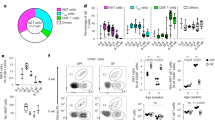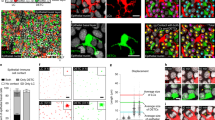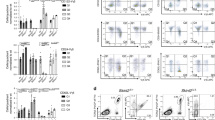Abstract
Lymphocytes are imprinted during activation with trafficking programs (combinations of adhesion and chemoattractant receptors) that target their migration to specific tissues and microenvironments. Cytokines contribute, but, for gut and skin, evolution has cleverly adapted external cues from food (vitamin A) and sunlight (ultraviolet-induced vitamin D3) to imprint lymphocyte homing to the small intestines and T cell migration into the epidermis. Dendritic cells are essential: they process the vitamins to their active metabolites (retinoic acid and 1,25(OH)2D3) for presentation with antigen to lymphocytes, and they help export environmental cues through lymphatics to draining lymph nodes, to program the trafficking and effector functions of naive T and B cells.
This is a preview of subscription content, access via your institution
Access options
Subscribe to this journal
Receive 12 print issues and online access
$209.00 per year
only $17.42 per issue
Buy this article
- Purchase on Springer Link
- Instant access to full article PDF
Prices may be subject to local taxes which are calculated during checkout

Katie Ris-Vicari

Katie Ris-Vicari
Similar content being viewed by others
References
Luster, A.D., Alon, R. & von Andrian, U.H. Immune cell migration in inflammation: present and future therapeutic targets. Nat. Immunol. 6, 1182–1190 (2005).
Johansson-Lindbom, B. & Agace, W.W. Generation of gut-homing T cells and their localization to the small intestinal mucosa. Immunol. Rev. 215, 226–242 (2007).
Schon, M.P., Zollner, T.M. & Boehncke, W.H. The molecular basis of lymphocyte recruitment to the skin: clues for pathogenesis and selective therapies of inflammatory disorders. J. Invest. Dermatol. 121, 951–962 (2003).
Butcher, E.C. The multistep model of leukocyte trafficking: a personal perspective from 15 years later. in Leukocyte Trafficking: Molecular Mechanisms, Therapeutic Targets, and Methods (eds. Hamann, A. & Engelhardt, B.) 3–13 (Wiley-VCH, Weinheim, Germany, 2005).
Butcher, E.C. & Picker, L.J. Lymphocyte homing and homeostasis. Science 272, 60–66 (1996).
Stolen, C.M. et al. Absence of the endothelial oxidase AOC3 leads to abnormal leukocyte traffic in vivo. Immunity 22, 105–115 (2005).
Honjo, M. et al. Lectin-like oxidized LDL receptor-1 is a cell-adhesion molecule involved in endotoxin-induced inflammation. Proc. Natl. Acad. Sci. USA 100, 1274–1279 (2003).
Jalkanen, S. et al. Lymphocyte migration into the skin: the role of lymphocyte homing receptor (CD44) and endothelial cell antigen (HECA-452). J. Invest. Dermatol. 94, 786–792 (1990).
Salmi, M., Tohka, S., Berg, E.L., Butcher, E.C. & Jalkanen, S. Vascular adhesion protein 1 (VAP-1) mediates lymphocyte subtype-specific, selectin-independent recognition of vascular endothelium in human lymph nodes. J. Exp. Med. 186, 589–600 (1997).
Mora, J.R. Homing imprinting and immunomodulation in the gut: role of dendritic cells and retinoids. Inflamm. Bowel Dis. 14, 275–289 (2008).
Salmi, M. & Jalkanen, S. Lymphocyte homing to the gut: attraction, adhesion, and commitment. Immunol. Rev. 206, 100–113 (2005).
Kupper, T.S. & Fuhlbrigge, R.C. Immune surveillance in the skin: mechanisms and clinical consequences. Nat. Rev. Immunol. 4, 211–222 (2004).
Arvilommi, A.M., Salmi, M., Kalimo, K. & Jalkanen, S. Lymphocyte binding to vascular endothelium in inflamed skin revisited: a central role for vascular adhesion protein-1 (VAP-1). Eur. J. Immunol. 26, 825–833 (1996).
Schaerli, P. et al. A Skin-selective homing mechanism for human immune surveillance T cells. J. Exp. Med. 199, 1265–1275 (2004).
Gunther, C. et al. CCL18 is expressed in atopic dermatitis and mediates skin homing of human memory T cells. J. Immunol. 174, 1723–1728 (2005).
Wardlaw, A.J., Guillen, C. & Morgan, A. Mechanisms of T cell migration to the lung. Clin. Exp. Allergy 35, 4–7 (2005).
Engelhardt, B. & Ransohoff, R.M. The ins and outs of T-lymphocyte trafficking to the CNS: anatomical sites and molecular mechanisms. Trends Immunol. 26, 485–495 (2005).
Kunkel, E.J. & Butcher, E.C. Plasma-cell homing. Nat. Rev. Immunol. 3, 822–829 (2003).
Hieshima, K. et al. CC chemokine ligands 25 and 28 play essential roles in intestinal extravasation of IgA antibody-secreting cells. J. Immunol. 173, 3668–3675 (2004).
Wilson, E. & Butcher, E.C. CCL28 controls immunoglobulin (Ig)A plasma cell accumulation in the lactating mammary gland and IgA antibody transfer to the neonate. J. Exp. Med. 200, 805–809 (2004).
Butcher, E.C. The regulation of lymphocyte traffic. Curr. Top. Microbiol. Immunol. 128, 85–122 (1986).
Young, A.J., Hay, J.B. & Mackay, C.R. Lymphocyte recirculation and life span in vivo. Curr. Top. Microbiol. Immunol. 184, 161–173 (1993).
Campbell, D.J. & Butcher, E.C. Rapid acquisition of tissue-specific homing phenotypes by CD4+ T cells activated in cutaneous or mucosal lymphoid tissues. J. Exp. Med. 195, 135–141 (2002).
Iwata, M. et al. Retinoic acid imprints gut-homing specificity on T cells. Immunity 21, 527–538 (2004).
Sigmundsdottir, H. et al. DCs metabolize sunlight-induced vitamin D3 to 'program' T cell attraction to the epidermal chemokine CCL27. Nat. Immunol. 8, 285–293 (2007).
Napoli, J.L. Retinoic acid biosynthesis and metabolism. FASEB J. 10, 993–1001 (1996).
Moore, T. Vitamin A and carotene. VI. The conversion of carotene to vitamin A in vivo. Biochem. J. 24, 692–702 (1930).
Svensson, M. et al. Retinoic acid receptor signaling levels and antigen dose regulate gut homing receptor expression on CD8+ T cells. Mucosal Immunol. 1, 38–48 (2008).
Johansson-Lindbom, B. et al. Functional specialization of gut CD103+ dendritic cells in the regulation of tissue-selective T cell homing. J. Exp. Med. 202, 1063–1073 (2005).
Szatmari, I. et al. PPARγ controls CD1d expression by turning on retinoic acid synthesis in developing human dendritic cells. J. Exp. Med. 203, 2351–2362 (2006).
Saurer, L., McCullough, K.C. & Summerfield, A. In vitro induction of mucosa-type dendritic cells by all-trans retinoic acid. J. Immunol. 179, 3504–3514 (2007).
Stenstad, H. et al. Gut-associated lymphoid tissue-primed CD4+ T cells display CCR9-dependent and -independent homing to the small intestine. Blood 107, 3447–3454 (2006).
Meurens, F. et al. Commensal bacteria and expression of two major intestinal chemokines, TECK/CCL25 and MEC/CCL28, and their receptors. PLoS ONE 2, e677 (2007).
Enioutina, E.Y., Bareyan, D. & Daynes, R.A. TLR ligands that stimulate the metabolism of vitamin D3 in activated murine dendritic cells can function as effective mucosal adjuvants to subcutaneously administered vaccines. Vaccine 26, 601–613 (2008).
Webb, A.R. & Holick, M.F. The role of sunlight in the cutaneous production of vitamin D3. Annu. Rev. Nutr. 8, 375–399 (1988).
Holick, M.F. et al. Photosynthesis of previtamin D3 in human skin and the physiologic consequences. Science 210, 203–205 (1980).
Prosser, D.E. & Jones, G. Enzymes involved in the activation and inactivation of vitamin D. Trends Biochem. Sci. 29, 664–673 (2004).
Lehmann, B., Rudolph, T., Pietzsch, J. & Meurer, M. Conversion of vitamin D3 to 1,25-dihydroxyvitamin D3 in human skin equivalents. Exp. Dermatol. 9, 97–103 (2000).
Liu, P.T. et al. Toll-like receptor triggering of a vitamin D-mediated human antimicrobial response. Science 311, 1770–1773 (2006).
Reiss, Y., Proudfoot, A.E., Power, C.A., Campbell, J.J. & Butcher, E.C. CC chemokine receptor (CCR)4 and the CCR10 ligand cutaneous T cell-attracting chemokine (CTACK) in lymphocyte trafficking to inflamed skin. J. Exp. Med. 194, 1541–1547 (2001).
Campbell, J.J. et al. The chemokine receptor CCR4 in vascular recognition by cutaneous but not intestinal memory T cells. Nature 400, 776–780 (1999).
Homey, B. et al. Cutting edge: the orphan chemokine receptor G protein-coupled receptor-2 (GPR-2, CCR10) binds the skin-associated chemokine CCL27 (CTACK/ALP/ILC). J. Immunol. 164, 3465–3470 (2000).
Lazarus, N.H. et al. A common mucosal chemokine (mucosae-associated epithelial chemokine/CCL28) selectively attracts IgA plasmablasts. J. Immunol. 170, 3799–3805 (2003).
Shirakawa, A.-K. et al. 1,25-Dihydroxyvitamin D3 induces CCR10 expression in terminally differentiating human B cells. J. Immunol. 180, 2786–2795 (2008).
Eksteen, B. et al. Epithelial inflammation is associated with CCL28 production and the recruitment of regulatory T cells expressing CCR10. J. Immunol. 177, 593–603 (2006).
Mangelsdorf, D.J. & Evans, R.M. The RXR heterodimers and orphan receptors. Cell 83, 841–850 (1995).
Mora, J.R. et al. Reciprocal and dynamic control of CD8 T cell homing by dendritic cells from skin- and gut-associated lymphoid tissues. J. Exp. Med. 201, 303–316 (2005).
Dudda, J.C. et al. Dendritic cells govern induction and reprogramming of polarized tissue-selective homing receptor patterns of T cells: important roles for soluble factors and tissue microenvironments. Eur. J. Immunol. 35, 1056–1065 (2005).
Boonstra, A. et al. 1α,25-Dihydroxyvitamin D3 has a direct effect on naive CD4+ T cells to enhance the development of Th2 cells. J. Immunol. 167, 4974–4980 (2001).
Iwata, M., Eshima, Y. & Kagechika, H. Retinoic acids exert direct effects on T cells to suppress Th1 development and enhance Th2 development via retinoic acid receptors. Int. Immunol. 15, 1017–1025 (2003).
Adorini, L. Tolerogenic dendritic cells induced by vitamin D receptor ligands enhance regulatory T cells inhibiting autoimmune diabetes. Ann. NY Acad. Sci. 987, 258–261 (2003).
Coombes, J.L. et al. A functionally specialized population of mucosal CD103+ DCs induces Foxp3+ regulatory T cells via a TGF-β and retinoic acid dependent mechanism. J. Exp. Med. 204, 1757–1764 (2007).
Kang, S.G. et al. Metabolites induce gut-homing FoxP3+ regulatory T cells. J. Immunol. 179, 3724–3733 (2007).
Benson, M.J., Pino-Lagos, K., Rosemblatt, M. & Noelle, R.J. All-trans retinoic acid mediates enhanced T reg cell growth, differentiation, and gut homing in the face of high levels of co-stimulation. J. Exp. Med. 204, 1765–1774 (2007).
Sun, C.-M. et al. Small intestine lamina propria dendritic cells promote de novo generation of Foxp3 T reg cells via retinoic acid. J. Exp. Med. 204, 1775–1785 (2007).
Mucida, D. et al. Reciprocal TH17 and regulatory T cell differentiation mediated by retinoic acid. Science 317, 256–260 (2007).
Gregori, S. et al. Regulatory T cells induced by 1α,25-dihydroxyvitamin D3 and mycophenolate mofetil treatment mediate transplantation tolerance. J. Immunol. 167, 1945–1953 (2001).
Prystowsky, J.H., Muzio, P.J., Sevran, S. & Clemens, T.L. Effect of UVB phototherapy and oral calcitriol (1,25-dihydroxyvitamin D3) on vitamin D photosynthesis in patients with psoriasis. J. Am. Acad. Dermatol. 35, 690–695 (1996).
Zhu, Y., Mahon, B.D., Froicu, M. & Cantorna, M.T. Calcium and 1α,25-dihydroxyvitamin D3 target the TNF-α pathway to suppress experimental inflammatory bowel disease. Eur. J. Immunol. 35, 217–224 (2005).
Penna, G., Amuchastegui, S., Laverny, G. & Adorini, L. Vitamin D receptor agonists in the treatment of autoimmune diseases: selective targeting of myeloid but not plasmacytoid dendritic cells. J. Bone Miner. Res. 22, V69–V73 (2007).
Kunkel, E.J. et al. CCR10 expression is a common feature of circulating and mucosal epithelial tissue IgA Ab-secreting cells. J. Clin. Invest. 111, 1001–1010 (2003).
Jaimes, M.C. et al. Maturation and trafficking markers on rotavirus-specific B cells during acute infection and convalescence in children. J. Virol. 78, 10967–10976 (2004).
Mora, J.R. et al. Generation of gut-homing IgA-secreting B cells by intestinal dendritic cells. Science 314, 1157–1160 (2006).
Kim, C.H. et al. Rules of chemokine receptor association with T cell polarization in vivo. J. Clin. Invest. 108, 1331–1339 (2001).
Wagers, A.J., Waters, C.M., Stoolman, L.M. & Kansas, G.S. Interleukin 12 and interleukin 4 control T cell adhesion to endothelial selectins through opposite effects on α1,3-fucosyltransferase VII gene expression. J. Exp. Med. 188, 2225–2231 (1998).
Picker, L.J. et al. Control of lymphocyte recirculation in man. II. Differential regulation of the cutaneous lymphocyte-associated antigen, a tissue-selective homing receptor for skin-homing T cells. J. Immunol. 150, 1122–1136 (1993).
Kim, C.H., Nagata, K. & Butcher, E.C. Dendritic cells support sequential reprogramming of chemoattractant receptor profiles during naive to effector T cell differentiation. J. Immunol. 171, 152–158 (2003).
Campbell, D.J., Kim, C.H. & Butcher, E.C. Separable effector T cell populations specialized for B cell help or tissue inflammation. Nat. Immunol. 2, 876–881 (2001).
Huehn, J. & Hamann, A. Homing to suppress: address codes for Treg migration. Trends Immunol. 26, 632–636 (2005).
Sather, B.D. et al. Altering the distribution of Foxp3+ regulatory T cells results in tissue-specific inflammatory disease. J. Exp. Med. 204, 1335–1347 (2007).
Acknowledgements
We thank A. Habtezion and C. Oderup for critical comments on the manuscript. Supported by Ruth L. Kirschstein National Research Service Award AI 66835-01A1 (H.S.); by US National Institutes of Health (NIH) grants AI72618, AI47822, AI059635, GM37734 and U19 AI057229 and a Merit Award from the Department of Veterans Affairs (E.C.B.); and by the FACS Core Facility of the Stanford Digestive Disease Center under NIH grant P30 DK56339.
Author information
Authors and Affiliations
Corresponding author
Rights and permissions
About this article
Cite this article
Sigmundsdottir, H., Butcher, E. Environmental cues, dendritic cells and the programming of tissue-selective lymphocyte trafficking. Nat Immunol 9, 981–987 (2008). https://doi.org/10.1038/ni.f.208
Published:
Issue Date:
DOI: https://doi.org/10.1038/ni.f.208
This article is cited by
-
Developmentally programmed early-age skin localization of iNKT cells supports local tissue development and homeostasis
Nature Immunology (2023)
-
The functional role of integrins during intra- and extravasation within the metastatic cascade
Molecular Cancer (2019)
-
T cells and the skin: from protective immunity to inflammatory skin disorders
Nature Reviews Immunology (2019)
-
A role for the CCR5–CCL5 interaction in the preferential migration of HSV-2-specific effector cells to the vaginal mucosa upon nasal immunization
Mucosal Immunology (2019)
-
Early treatment of SIV+ macaques with an α4β7 mAb alters virus distribution and preserves CD4+ T cells in later stages of infection
Mucosal Immunology (2018)



